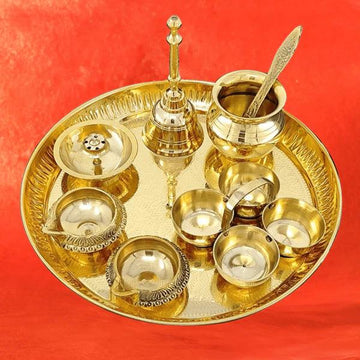Pooja bells, or ghantas, are a quintessential part of Hindu rituals, often seen adorning temples and home altars alike. Their melodic chime is more than just a call to worship; it carries deep spiritual significance and plays a vital role in various ceremonies. This blog explores the history, symbolism, and importance of pooja bells in Hindu rituals.
Historical Significance
The use of bells in spiritual practices dates back thousands of years. In ancient Hindu scriptures, bells are mentioned as instruments to invoke divine presence and ward off evil spirits. Their sound is believed to create a connection between the physical and spiritual realms, making them an integral part of temple architecture and rituals.
Symbolism of Pooja Bells
Pooja bells hold rich symbolic meanings in Hindu culture:
Awakening the Divine: The sound of the bell is thought to awaken the deity being worshipped, inviting them to partake in the ceremony.
Dispelling Negativity: The vibrations produced by the bell are believed to cleanse the environment of negative energies and purify the space.
Focus and Concentration: Ringing the bell signals the beginning of a ritual, helping devotees to focus their minds and concentrate on the worship.
Sound of Om: The reverberating sound of the bell is likened to the sacred syllable "Om," which represents the universal consciousness and the essence of the ultimate reality.
Types of Pooja Bells
Pooja bells come in various shapes, sizes, and materials, each serving different purposes:
Handheld Bells: Commonly used in household rituals, these small bells are easy to hold and ring during prayers.
Temple Bells: Large bells found in temples, often rung by devotees before entering the sanctum. These bells produce a deep, resonant sound that can be heard over long distances.
Ghanti: A bell with a handle often shaped like a deity or sacred symbol. It is used during aarti (waving of light) and other ceremonial rites.
The Role of Bells in Hindu Rituals
Invoking Deities
The ringing of a bell marks the beginning of a pooja (worship) and is intended to attract the attention of the deities. It is a way to communicate with the divine, signaling the start of prayers and offerings.
Purification
The sound waves produced by a bell are believed to have a purifying effect. When a bell is rung, the vibrations help to dispel negative energies and create a sanctified atmosphere conducive to worship.
Enhancing Devotion
The rhythmic ringing of the bell during rituals helps devotees to synchronize their minds and hearts with the divine. It aids in maintaining concentration and devotion, ensuring that the worship is conducted with a focused and pure mind.
Accompanying Rituals
Bells are used in various stages of Hindu rituals:
Aarti: During the waving of the lighted lamp, the bell is rung to complement the offering of light to the deity.
Puja Thali: The bell is often placed on the puja thali (plate) along with other offerings like flowers, incense, and holy water.
Mantra Chanting: Bells are rung while chanting mantras to enhance the spiritual vibrations and invoke divine blessings.
How to Use a Pooja Bell
Using a pooja bell is simple yet significant. Here are some tips:
Timing: Ring the bell at the start of the pooja to invite the deity and during specific rituals like aarti and mantra chanting.
Placement: Keep the bell in a clean and sacred place, preferably on the altar or near the pooja setup.
Pooja bells are more than just musical instruments; they are powerful tools that bridge the gap between the material and spiritual worlds. Their sound purifies, invokes, and uplifts, creating a sacred space for devotion and connection with the divine. Understanding the role of pooja bells in Hindu rituals enriches the worship experience, deepening the spiritual engagement and honoring the traditions passed down through generations. Whether in a grand temple or a humble home, the chime of a pooja bell resonates with the timeless essence of Hindu spirituality.














